
|
|
|
|
 |
|
Home Site Search Contact Us Subscribe
|
|
|
|
Green Values: Environmental Defense Office by Envision Design (updated January 2005)
Washington, DC: An environmental organization doesn't give up having a beautiful space just so it can be "green." by Kristen Richards October 29, 2002 UPDATE: January 2005 – This project was recently awarded
a Silver Rating under the U.S. Green Building Council’s LEED Commercial
Interiors Pilot Rating System. Other awards received since opening in 2002 include: -- International Interior Design Association (IIDA)
Mid-Atlantic Chapter: Best Sustainable Design -- AIA Washington Chapter: Presidential Citation for
Sustainable Design -- Environmental
Design + Construction magazine:
First Annual Excellence Award -- Contract magazine: Interiors Award in Green
Design Environmental
Defense is a nationally recognized environmental organization known for its
ability to work closely with major corporations in developing environmentally
responsible solutions to problems. The client charged Envision Design to create
its Washington, DC, office as a model for the organization’s environmental
values. The 16,144-square-foot space on the sixth floor in an existing
high-rise is filled with natural light, healthy for the staff, built on a
reasonable budget – and has minimal impact on the environment. “This
was an
aggressively environmental and visually sophisticated interiors project,” says
Ken Wilson, AIA, Envision Design’s Principal-in-Charge. “When we started out on
a sustainable path three years ago with the design of the Greenpeace USA
headquarters (our first project as a firm), we looked at other ‘green’ spaces
and were not impressed. They all seemed a little, well, bland. But you don't
have to give up having a beautiful space by making it green – and you get so
much back.” From
the moment visitors arrive in the elevator lobby, there are views through the
space to the outside. Playful elliptical forms on the lower half of glass doors
at the entrance and on the conference room doors serve several purposes. “In a space with so much
floor to ceiling glass, it was important to mark the glass is some way for
safety reasons,” Wilson explains. “We also wanted to cover up the cluttered
look of conference chair casters and the like.” The ellipses came out of the
idea of creating organic imagery without being literal, like dolphins or
butterflies. “The shapes are whatever you want them to be,” says Wilson. “Some people see petals, some see lily pads,
and some see cells.” Ellipses made of agriboard are repeated
in various shapes and sizes, and attached randomly to the exposed painted
ceiling in the reception area. Private
interior offices have floor-to-ceiling glass walls, so every office and
workstation has a view to the outside from
a seated position. “The positive affect of natural light is well documented. It
is very important to the overall well-being of people to sense the changes of
the sun over the course of the day and even to be aware of the weather
conditions,” Wilson says. “From an interior office, even though you are looking
past an open workstation and through a perimeter office beyond, you still get
that much needed connection to the outside.” Among the challenges to the
design team were the long, narrow proportions of the space, and extremely low
ceiling heights (only 8½ feet slab to slab). In addition, the
program required spatial efficiency and flexibility within a compact plan. Workspaces are
standardized in three identical types: perimeter offices (120 square feet), open
workstations (56 square feet), and interior offices (100 square feet). As
various programs grow or contract, offices within the same type are
interchangeable. Additionally, 120-square-foot “huddle rooms” are sized to
become offices if need be. The
large conference room may be sub-divided into separate rooms with an
acoustically rated operable partition. One side of the room has predominately
clear glass doors, and the other side has mostly translucent doors for privacy.
A series of full height glass panels pivot open to the reception area to allow
free flow of people between the two spaces during large gatherings. The custom
designed sectional conference table can be arranged in a variety of
configurations. The modesty panels are removable and table legs fold flat for
easy storage. Every
material incorporated into the project was scrutinized for its environmental
qualities, and also had to meet the highest functional and aesthetic standards.
The majority of materials are high in recycled content including: gypsum board
100%; rubber flooring 100%; seating fabric 100%; ceiling panels 74%; ceramic
tile 55%; and carpet 25%. Zero VOC paints and zero or very low VOC adhesives
were used throughout. Open workstations, office desks, and conference tables
were custom designed from eco-friendly materials including FSC certified wood,
wheatboard, and bio-composite board. Break room tables are made of a wood resin
material that can be recycled back into itself. Two-thirds of the office
seating was salvaged or reused. All file cabinets were salvaged or purchased
used and refurbished. In many areas, including the perimeter offices, ceilings
have been left exposed to the existing slab and painted, reducing the need for
ceiling materials. Even the method of creating the elliptical forms on the
glass doors was considered. As Wilson explains: “We wanted to avoid actually etching the glass because
of the permanence and lack of future flexibility. We also wanted to avoid the
use of any vinyl products, which most of the films are made of. While doing
some online research, I actually discovered the acrylic film (non-vinyl) we
ended up using. The film is applied on alternating sides of the glass that
creates the ‘overlapped’ look.” Energy efficient fluorescent
lighting used throughout and occupancy sensors in all offices reduce energy
consumption. Carbon dioxide sensors monitor air quality and special filters
remove off-gassing from copy machines. Recycling stations are placed in
multiple locations. The office is located in the
Kalorama area of the District, a high-density urban environment, with hotels,
conference centers, restaurants, retail stores, a post office, movie theaters,
galleries, nightlife, health club, and housing located within a one-block
radius. Multiple bus lines stop in front of the building, and there’s an
underground Metro Rail station within one-half mile. The building offers
bicycle storage, and a shower facility is provided within tenant space. The project was completed in
January 2002, and is under consideration to be one of the first pilot projects
for the new LEED Commercial Interiors
Rating System. Client: Environmental Defense, A.J. Pietrantone, Director of Finance and
Administration (owner’s representative) Architect: Envision Design, PLLC Project Team: Kendall P. Wilson AIA (Principal-in-Charge), Kendra
Guiffre, AIA, Dawn Congdon, Michael Janas, Alexis Gregory General Contractor: Rand Construction Corporation Construction Manager: The Staubach Company MEP Engineer/ Audio/Visual Designer: GHT, Ltd. Millwork: LCM Photographer: Michael Moran Photography, New York City - tel: 212-334-4543 Envision Design was founded in 1999 by Ken Wilson, AIA, and through a partnership with
Diana Horvat, the firm has grown to a staff of 21. Based in Washington, DC, the
diversified practice works nationally on commercial interiors,
retail/entertainment, building renovation, and new base building construction,
with a committed focus on sustainable design. Manufacturers/Suppliers: Flooring: Shaw Contract (carpet); GreenWood Products Co.
(bamboo); DodgeRegupol (rubber); TerraGreen Ceramics, Inc. (ceramic tile);
Johnsonite (rubber base); LCM (wood base) Seating: Herman Miller; Davis Furniture; Brayton
International; Keilhauer; HON Fabrics: DesignTex, Sina Pearson Textiles (upholstery);
Carnegie (wall panels); Forbo (tack boards); Nysan Shading Systems (black-out
shades) Tables: Bernhardt; LCM Files/Pedestals: Reform Keyboard Trays: AllSteel Lighting: Cooper Lighting; Poulsen Lighting Inc.;
Elliptipar; Corelite; The Watt Stopper, Inc.; Artemide Ceiling tiles: USG Paint: Sherwin-Williams Appliances: General Electric; Asko; Brite Way; Vulcain Alarm
Corporation (carbon dioxide monitors) Finishes: National Gypsum (Gypsum board); National Starch
& Chemical; L. Fishman & Sons; Chicago Adhesive Products Co.; Franklin
International; Isotec International Inc.; DodgeRegupol (adhesives); CPFilms
(frosted window films); BonaKemi USA Inc. (floor finish) |
(click on pictures to enlarge) 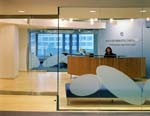 (Michael Moran) From the elevator lobby, the transparency of the Environmental Defense office is obvious.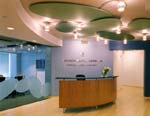 (Michael Moran) Organic forms are etched in glass doors and float from the ceiling.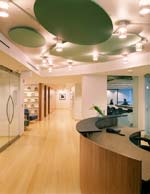 (Michael Moran) Reception area.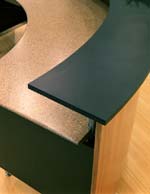 (Michael Moran) The custom reception desk is made of bio-composite panel material containing sunflower seed hulls, FSC certified cherry veneer on agriboard front panels, and transaction ledge of wood resin.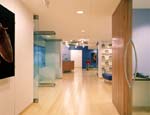 (Michael Moran) View from corridor to reception area: doors on conference rooms pivot open to enlarge the space for gatherings.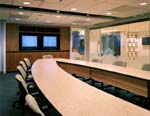 (Michael Moran) The sectional conference room table can be easily reconfigured (and stored).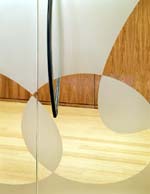 (Michael Moran) Glass door detail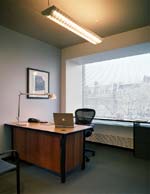 (Michael Moran) Typical perimeter office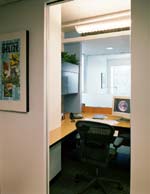 (Michael Moran) Typical interior office: full-height glass wall offers natural light and views to the outside.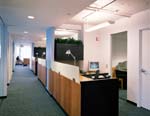 (Michael Moran) Workstations have agriboard tops, supports, and overhead cabinets with a zero VOC finish system that is UV cured.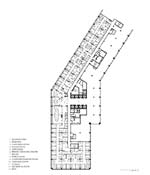 (Envision Design) Floorplan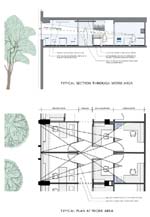 (Envision Design) Section and plan of typical work area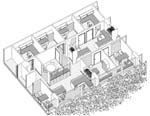 (Envision Design) Axonometric of work area |
© 2005 ArchNewsNow.com